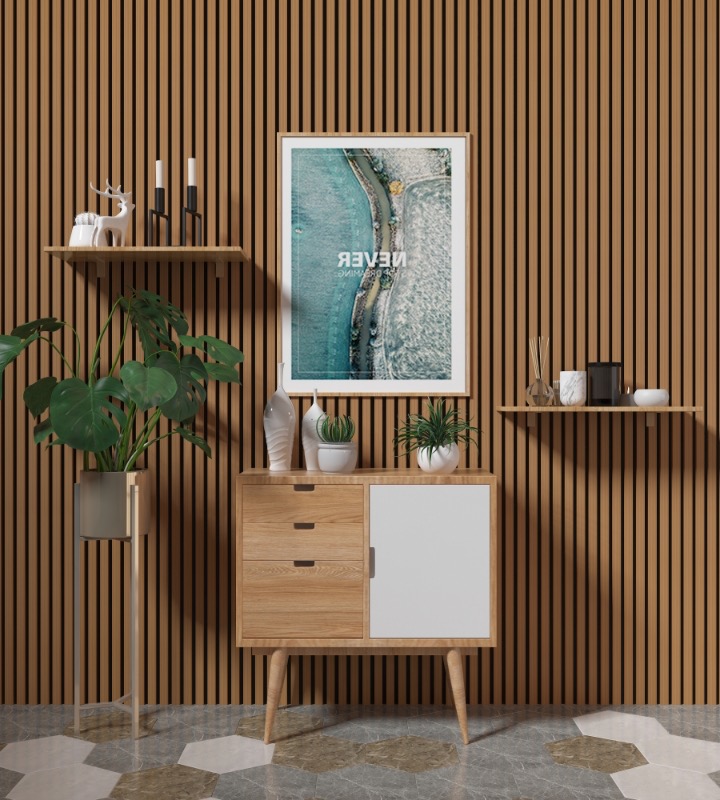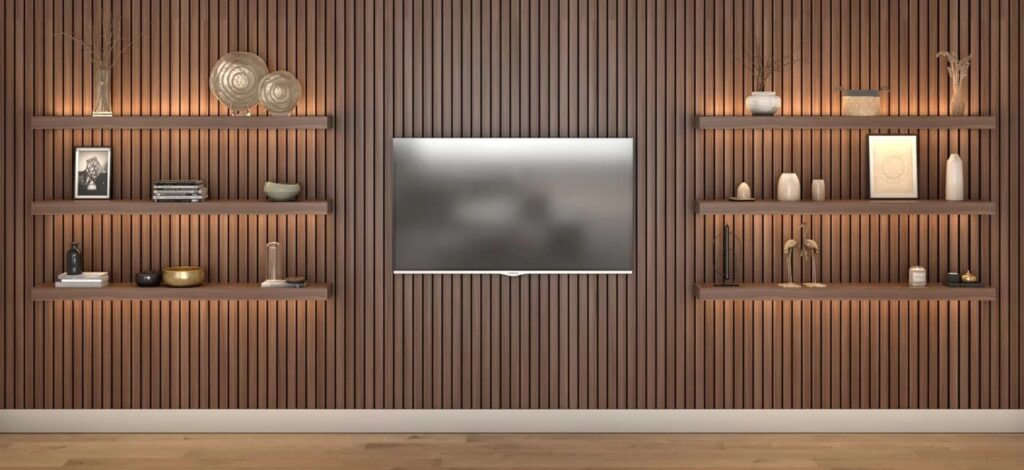WPC Wall Panel Design Ideas & Trends
Wood Plastic Composite (WPC) wall panels have revolutionized interior design by offering the perfect blend of natural wood aesthetics and modern durability. As we move through 2025, these versatile panels continue to gain popularity for their sustainability, functionality, and stunning visual appeal. Whether you’re renovating your home or designing a commercial space, WPC wall panels provide endless creative possibilities to elevate any interior. This comprehensive guide explores the latest design trends, innovative applications, and practical benefits of incorporating WPC wall panels into your space.
What Are WPC Wall Panels?
WPC wall panels are premium decorative materials crafted from Wood-Plastic Composite – a sustainable combination of wood fibers or flour and thermoplastics such as polyethylene (PE), polypropylene (PP), or polyvinyl chloride (PVC). This innovative composition delivers the warm, natural appearance of wood while offering enhanced durability and resistance to environmental factors. Unlike traditional wood panels, WPC doesn’t warp, rot, or require extensive maintenance, making it an ideal choice for modern interiors.
The manufacturing process typically involves thoroughly mixing ground wood particles with heated thermoplastic resin, then extruding the material into desired shapes and designs. The result is a versatile product that can be tailored to various textures, colors, and finishes to suit any design aesthetic.
Benefits of WPC Wall Panels
Durability and Longevity
One of the most significant advantages of WPC wall panels is their exceptional durability. These panels resist moisture, UV rays, and other elements that typically wear down traditional materials. Unlike natural wood, WPC won’t warp, rot, or fade over time, ensuring your interior looks pristine for years to come. This longevity makes them a cost-effective solution despite the higher initial investment compared to some traditional options.
Sustainability
As environmental concerns grow, WPC panels have become a staple in sustainable interior design. Manufactured using recycled wood fibers and plastic, these panels contribute to reducing deforestation and plastic waste. Many manufacturers now offer WPC panels made with post-consumer recycled wood fibers, making them an environmentally responsible choice for eco-conscious homeowners and designers.
Low Maintenance Requirements
WPC wall panels require minimal maintenance compared to traditional wood panels. They don’t need regular painting, staining, or sealing to maintain their appearance. A simple occasional cleaning is sufficient to keep them looking fresh and new, saving time and resources throughout their lifespan.
Acoustic and Thermal Performance
Beyond aesthetic appeal, WPC panels offer excellent acoustic and thermal insulation properties. They effectively reduce noise transmission between rooms and help maintain comfortable indoor temperatures[9]. This makes them particularly valuable in residential settings, offices, and commercial spaces where sound management and energy efficiency are priorities.
Latest WPC Wall Panel Design Trends for 2025
Textured Finishes
Textured WPC panels have surged in popularity as they add depth and visual interest to walls. These textures mimic organic patterns found in real wood, offering a natural feel with minimal maintenance requirements. In 2025, we’re seeing increased demand for deeply embossed wood grain patterns that create tactile richness on walls, perfect for adding character to minimalist spaces.
3D Wall Panels
Three-dimensional WPC wall panels create striking visual effects through their sculptural qualities. These innovative panels play with light and shadow, adding dramatic dimension to otherwise flat surfaces. The 3D fluted curved panels, measuring approximately 95″ x 6.5″ x 0.9″, have become particularly popular for creating sophisticated, contemporary spaces with architectural interest.
Bold Colors and Contrasting Tones
While natural wood tones remain classic choices, 2025 is witnessing a shift toward more vibrant, bold colors in WPC wall panels. Deep greens, blues, and even statement reds are being used to create stunning accent walls and dramatic statements in modern interiors. These richer hues work exceptionally well in contemporary and eclectic design schemes, adding personality and energy to spaces.
Mixed Materials
Contemporary design increasingly incorporates mixed materials for a layered, multidimensional effect. WPC panels are frequently combined with glass, concrete, and metals to create dynamic visual interes. Metal inlays within WPC panels-using gold or silver strips-provide an industrial-chic aesthetic that elevates standard wall treatments to artistic installations.
Design Ideas for Different Spaces
Modern Minimalist Living Rooms
For minimalist living spaces, light-toned WPC panels in ash, light oak, or white-washed finishes create an open, airy atmosphere. Seamless installations with minimal visible joints enhance the clean, uncluttered aesthetic that defines minimalist design. These panels work beautifully as full wall treatments or as strategic accent walls behind sofas or entertainment units.
Rustic and Farmhouse Interiors
To achieve a rustic or farmhouse aesthetic, opt for WPC panels with distressed, weathered appearances that evoke the charm of reclaimed wood. Dark mahogany, walnut, or cedar finishes add warmth and character, complementing cozy furniture and vintage-inspired décor. A vertical shiplap-style installation can draw the eye upward, making rooms appear taller and more spacious.
Industrial-Style Spaces
Industrial design embraces raw, unfinished materials and textures. WPC panels with matte or dark finishes paired with exposed metal elements create the perfect urban edge. Consider rough-textured panels or those with 3D patterns to emphasize the raw quality characteristic of industrial design while maintaining the practical benefits of WPC materials.
Contemporary Office Environments
In professional settings, WPC wall panels offer both aesthetic appeal and functional benefits. High-gloss finishes in sophisticated tones create an impression of luxury and precision, while the acoustic properties help manage noise levels in busy workspaces. Feature walls with geometric patterns or subtle textures can define different functional areas while maintaining a cohesive design language throughout the office.
Elegant Entryways
Make a striking first impression by installing WPC panels in your home’s entrance. A white shiplap wall treatment can give your entryway an eye-catching look while creating a warm, welcoming atmosphere. Pair with a wooden bench and potted plants for a balanced, inviting space that sets the tone for the rest of your home.
Accent Wall Strategies
When using WPC panels for accent walls, consider these designer-approved approaches:
- Extend wall panels along the ceiling to create a cohesive, enveloping effect
- Use paneling to frame artwork or statement pieces, creating a gallery-like focal point
- Experiment with dark colors for dramatic contrast against lighter furnishings
- Layer panels with varying depths to create subtle dimensional effects
- Cover chimney breasts or other architectural features for a unified design statement
Installation & Maintenance Tips
WPC wall panels are designed for straightforward installation, often featuring interlocking systems that require no special tools or expertise. They can be installed directly onto walls or ceilings and cut to fit any size or shape, making them highly adaptable for various spaces. For optimal results, ensure the underlying wall surface is clean, dry, and level before installation.
Maintenance couldn’t be simpler – WPC panels resist moisture, stains, and scratches, requiring only occasional cleaning with mild soap and water to maintain their appearance. Unlike natural wood, they won’t need refinishing or resealing over time, saving significant maintenance costs and effort throughout their lifespan.
Environmental Impact and Sustainability
As climate awareness grows, the environmental benefits of WPC panels become increasingly important. These panels often incorporate recycled materials, reducing both deforestation and plastic waste. According to Oklahoma State University’s research, WPC products represent a significant step toward sustainable building practices by repurposing waste materials into durable, functional building components.
When choosing WPC panels, look for manufacturers who prioritize sustainable practices and use high percentages of recycled content in their products. This ensures your design choices contribute positively to environmental conservation efforts.
Where to Find Quality WPC Wall Panels
At Canada Plastics & Belting, we offer a premium selection of WPC wall panels suitable for various applications. Our extensive inventory includes fluted panels, textured designs, and panels in a range of colors and finishes to suit any design vision. As specialists in high-quality building materials, we provide personalized guidance to help you select the perfect panels for your project.
Visit our showroom to explore our collection of WPC wall panels and speak with our design experts about how these versatile materials can transform your space. We offer samples and support for both current and future projects, ensuring you achieve the perfect balance of aesthetics and functionality.
Conclusion
WPC wall panels represent the perfect marriage of natural beauty, modern durability, and environmental responsibility. As design trends continue to evolve in 2025, these versatile panels offer limitless possibilities for creating stunning, functional interior spaces. Whether you’re drawn to minimalist clean lines, rustic warmth, industrial edge, or contemporary elegance, WPC panels provide the perfect canvas for expressing your unique design vision while ensuring longevity and minimal maintenance.
By incorporating these innovative materials into your design plans, you’ll create spaces that not only look beautiful today but will continue to perform exceptionally well for years to come. The combination of aesthetic versatility, practical benefits, and environmental advantages makes WPC wall panels one of the smartest investments you can make in your interior design journey.


